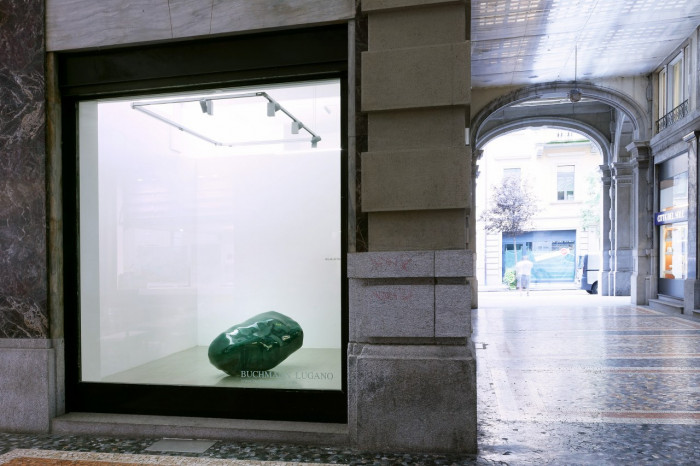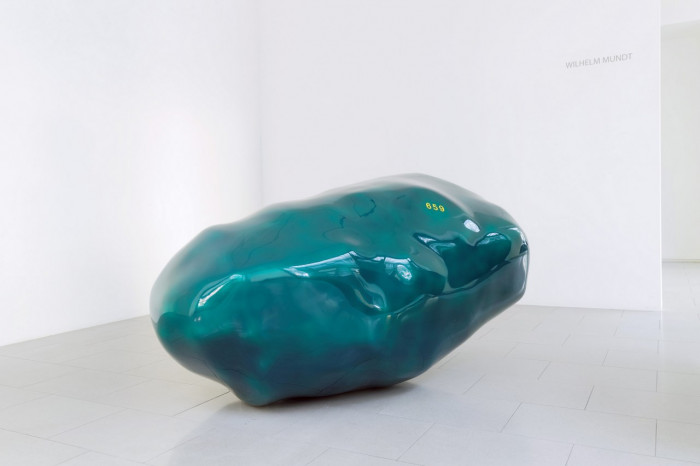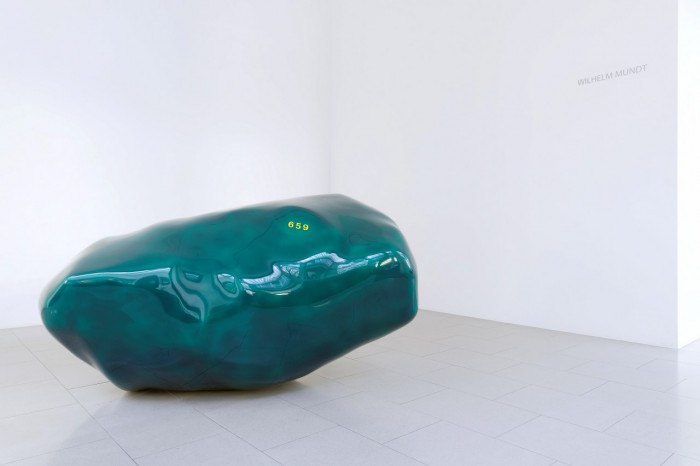Wilhelm Mundt 659
The Buchmann Lugano city space will present the world premiere of a new work of art, Trashstone 659 by the German artist, Wilhelm Mundt (*1959, Grevenbroich), on Saturday 27 August from 5.00 pm.
Wilhelm Mundt studied at the Kunstakademie of Düsseldorf where he later, from 1989 to 1991, had a teaching assignment. From 2009, he has has a professorship at the Hochschule für Bildende Künste in Dresden. Today, he lives and works in Rommerskirchen, a small city in Northern Rhineland-Westphalia, not far from Cologne.
The Trashstones constitute the most representative and best-known group of works by Wilhelm Mundt. The artist began to create these sculptures in 1989. They consist essentially of inorganic waste materials produced in his studio, coated in a coloured polyurethane resin. It is thus the content that assumes a great importance because it has the duty of giving form to the sculpture. However, the form is not recognizable or identifiable, but is what can be defined as ‘amorphous’. In addition, the various layers of colour applied one after another so as to completely surround to production wastes, contribute to creating the work and to completing the sculptural process. From the start, Mundt has meticulously numbered each work with a sequential triple-digit number that appears on the external surface of each example. Each Trashstone is a unique piece, and differs in the form or the colour from all the others. To date, there are more than 600 individual works of art.
The Lugano space is proud to present a new type of Trashstone, never shown to the public previously. In fact, Trashstone 659 is the particular outcome of a colour experimentation conducted in secret by the artist during recent years. It seems that the intent to present precisely this work at Lugano, followed upon a visit by the artist to the city on the banks of the Ceresio River. Actually, in his opinion, the colour of Trashstone 659 refers not only to the green slabs of marble that cover the building of the LAC, but also to the green turf, the green of the olive trees and of the cypresses growing in the adjacent court.
Works by Wilhelm Mundt have been exhibited recently at the Lehmbruck Museum, Duisburg (2010); Arp Museum Bahnhof Rolandseck, Remagen (2011); National Center for Contemporary Art (NCCA), Moscow (2012); K20 Grabbeplatz (2013) and Museum Kunstpalast (2014), Düsseldorf; Musées royaux des Beaux-Arts de Belgique, Bruxelles (2015); and Palazzo Reale, Milan (2016). His works are included in collections such as those of the Kunstmuseum St. Gallen, the Margulies Collection in Miami, Lehmbruck Museum in Duisburg, the Bayreuth University collection, MunichRE, BNP Parisbas, and Vestas Aarhus.
For more information:
Buchmann Lugano
Via della Posta 2, CH-6900 Lugano
From 30 August
Tuesdays - Fridays: 1.00 - 6.00 pm
Saturdays 1.00 pm - 5.00 pm
Lo spazio cittadino Buchmann Lugano presenta sabato 27 agosto a partire dalle ore 17.00 la nuova opera, mai esposta in precedenza, Trashstone 659 dell’artista tedesco Wilhelm Mundt (*1959, Grevenbroich).
Wilhelm Mundt si è formato presso la Kunstakademie di Düsseldorf, dove poi, dal 1989 al 1991, ha insegnato su incarico; dal 2009 detiene una cattedra presso la Hochschule für Bildende Künste Dresden. Oggi vive e lavora a Rommerskirchen, cittadina situata nella Renania Settentrionale-Vestfalia, nei pressi di Colonia.
Le Trashstone costituiscono il gruppo di opere più rappresentativo e conosciuto di Wilhelm Mundt. Nel 1989 l’artista ha iniziato a creare queste sculture, che consistono essenzialmente in scarti di produzione inorganici ricavati dal suo studio, rivestiti da una resina colorata in poliuretano. È dunque il contenuto ad assumere grande importanza, siccome ha il compito di dare forma alla scultura; forma che però non è riconoscibile o identificabile, ma che può essere definita una ‘amorfa’. Oltre a ciò, i vari strati di colore, applicati uno dopo l’altro fino ad avvolgere completamente gli scarti di produzione, contribuiscono a creare l’opera e completare il processo scultoreo. Sin dal principio, Mundt ha meticolosamente numerato in ordine progressivo ogni opera con un numero a tre cifre che compare sulla superficie esterna di ogni esemplare. Ogni Trashstone è un pezzo unico, e si differenzia per la forma o per il colore da ogni altra. Ad oggi si contano più di 600 singole opere.
Lo spazio di Lugano ha la fortuna di ospitare un nuovo tipo di Trashstone, finora mai presentata al pubblico. Infatti, Trashstone 659 è il particolare risultato di una sperimentazione sul colore, portata avanti in segreto dall’artista durante questi ultimi anni. La volontà di presentare proprio quest’opera a Lugano, pare essere nata a seguito di una visita dell’artista nella città sulle rive del Ceresio. In effetti, a suo dire, il colore della Trashstone 659 richiama non solo le verdi lastre di marmo che ricoprono l’edificio del LAC, ma anche il verde del prato, dell’ulivo e dei cipressi nell’adiacente corte.
Le opere di Wilhelm Mundt sono state esposte di recente presso il Lehmbruck Museum Duisburg (2010), Arp Museum Bahnhof Rolandseck, Remagen (2011), National Center For Contemporary Art (NCCA), Mosca (2012), K20 Grabbeplatz (2013) e Museum Kunstpalast (2014) Düsseldorf, Musées royaux des Beaux-Arts de Belgique, Bruxelles (2015), Palazzo Reale, Milano (2016). I suoi lavori fanno parte di collezioni quali Kunstmuseum St. Gallen, Margulies Collection Miami, Lehmbruck Museum Duisburg, Universität Bayreuth, MunichRE, BNP Parisbas, e Vestas Aarhus.
Per maggiori informazioni:
Buchmann Lugano
Via della Posta 2, CH-6900 Lugano
Dal 30 agosto
Dal martedì al venerdì 13.00 – 18.00
Sabato 13.00 – 17.00
Wilhelm Mundt
Born 1959 in Grevenbroich. Lives and works in Rommerskirchen, Cologne and Dresden.
2009 - Professorship at University of Fine Arts, Dresden
1989 - 91 Teaching assignment at Kunstakademie Düsseldorf
| 1979 - 86 | Kunstakademie Düsseldorf |
| 2007 | Jack Goldhill Award for Sculpture, Royal Academy of Arts, London |
| 1986 | Scholarship Kunstfonds e.V., Bonn |
Universität St Gallen
Kunstmuseum Bonn
Lehmbruck Museum, Duisburg
Museum Kunstpalast, Düsseldorf
Kunstmuseum St. Gallen
Margulies Collection, Miami
Société Générale Collection, Paris
Universität Bayreuth
MunichRe, München
Vestas, Aarhus




